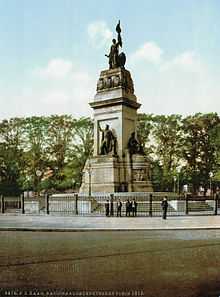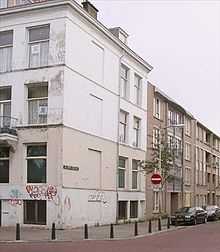The Hague Center
| Location of Centrum | |
| Gemeente: | The Hague |
|---|---|
| Stadsdeel: | |
| Population: | 99,283 |
The City Center of The Hague (Dutch: Centrum) is the oldest and, with a population of 99,283 inhabitants (as of 1 January 2013),[1] the second largest of The Hague's eight districts, consisting of nine neighbourhoods.[2] Two railways stations can be found in the city center: Den Haag Centraal en Den Haag Hollands Spoor.
Archipelbuurt

The neighbourhood Archipelbuurt / Willemspark was largely built at the end of the 19th century. On the south-west border is a Jewish cemetery that dates back to 1694. Later on both the non-denominational and Roman Catholic cemeteries were also situated in this location. The neighbourhood has many wide avenues and streets with large houses, although housing in the smaller streets is more modest. There are even so-called 'hofjeswoningen', an early form of socialized housing. A lot of the large houses nowadays are used as offices, for example at the Nassauplein, the Koninginnegracht and the Laan Copes van Cattenburgh. On the southern border of the Archipelbuurt there are newly built offices, the police headquarters and the Nationale Investeringsbank (National Investment Bank).
Oude Centrum

The Oude Centrum (Old Center) forms the heart of The Hague, which includes the Binnenhof and Hofvijver, the Noordeinde Palace, the Mauritshuis museum, and the City Hall of The Hague. The history of the old center is reflected in the architectural diversity that can be found in this part of the city center, ranging from 17th century Renaissance to 20th century expressionism.
Schilderswijk
The Schilderswijk is still one of the poorest neighbourhoods of the Netherlands. Unemployment is significant, and many people are dependent of governmental support. In 2006 (the latest available figures), 70% of the inhabitants of the Schilderswijk had a low income, 25% a middle income, and 5% a high income. In 3450 residents in 2007 undertook paid employment or self, the magnitude of the potential workforce (the number of people aged 15–64) was in 2008 22,253. Of all households in the district lived in Painting in 2007 42% of the poverty line from 16% in The Hague
More than 90% of the registered residents are of non-Western origin - notably Turkish, Moroccan and Surinamese. Of the housing stock approximately 25% is privately owned, these homes are often rented. The remaining houses are owned by housing HaagWonen. Especially in the eastern part of the Schilderswijk (Orange Square and around the station Holland Spoor) some problems have been addressed, so the renewed Orange Square, have built larger homes including houses for sale, for example the new Mirador project, and the prostitution in the coil Dijksestraat disappeared . This street is changed in the Wolterbeek Street.
The migration changed the district not only physically but also socially. The investment by the government to solve the problems of urban renewal in the district not, the unemployment remained high, the neighborhood quickly deteriorated again, crime increased and there was nuisance of drug addicts, vandalism and graffiti. The response from the community was a social community development, welfare and housing associations which were deployed. The approach consisted mainly of amenity programs. Thus, many such residents to activities funded social cohesion in the area to strengthen. Also, many small changes made to the social security and increase the pollution abatement, such as better lighting and more garbage.
Stationsbuurt

Many original buildings from the late 19th and early 20th century were demolished and replaced by new buildings in the 1970s and 1980s in the context of an urban renewal that started around 1975. The area between Station and Hollands Spoor Rijswijkseplein, for instance, had been completely renovated. From 2000 on, the district was renovated once again, this time with more respect for the historic value of buildings. Besides the demolition and replacement of old houses, a lot of houses were renovated instead, an example being the Orange Square, in 2003. Despite all the innovation, a few monumental buildings can be found in the Stationsbuurt, such as the houses of the Huygens Park, Groenewegje, Bierkade, Dunne Bierkade and Oranjeplein, and some monumental houses can still be found at the Stationsweg. At the Van Hogendorpstraat, a "labourer's courtyard" can still be found. Many companies are located in the Stationsbuurt, in particular due to the proximity of public transport. In 1981 a plan was adopted by the municipality that would make sure that the residential function of the neighbourhood would be retained.
Kortenbos
Kortenbos consists of two separate parts. Most inhabitants of The Hague define Kortenbos as the area between the Jan Hendrikstraat/Torenstraat, Noordwal, Lijnbaan and Prinsegracht. This is the area where the neighborhood association is active. However, the area north of the Torenstraat/Jan Hendirkstraat is also part of the neighbourhood. This is the Hofkwartier district, located around the Molenstraat, Oude Molstraat and Noordeinde.
Kortenbos' main function is living. In earlier days there were a lot of small companies and some larger companies, for example the Zuid Hollandse Bierbrouwerijen (South Holland Brewery) located on the Noordwal. The neighbourhood was partly reorganised in the early 1930s, with a second, more intense reorganisation in the 1970s. A lot of old houses and industrial buildings were demolished and replaced with new buildings, mainly socialized housing. The two 'hofjes' in Kortenbos were tidied up; the monumental 'Hofje van Nieuwkoop' and the 'Hofje van Vredebest'. The renovation was officially finished in 1991, although a new project was started immediately after, involving housing on the former location of the bathhouse on the Torenstraat.
Transvaal
Transvaal is a multi-ethnic area with 15.472 inhabitants as of 1 January 2013. Starting in the 1990s, many poor houses were demolished to make room for new buildings. This significantly changed the character of the neighbourhood. Transvaal changed from a popular to a multicultural neighbourhood. As of 2013, immigrants make up over 90% of the neighbourhood's population, primarily Moroccan, Turkish, and Surinamese people.[1]
| 2012 | Numbers | % |
|---|---|---|
| Total population | 15,472 | 100.0 |
| Dutch natives | 1,254 | 8.1 |
| Western immigrants | 2,120 | 13.7 |
| Non-Western immigrants | 12,098 | 78.1 |
| Suriname | 3,500 | 22.6 |
| Morocco | 1,910 | 12.3 |
| Turkey | 4,470 | 28.9 |
| Antilles | 312 | 2.0 |
| Others | 1,906 | 12.3 |
Transvaal is not a wealthy neighborhood; recent figures show that 71% of households has a low income, 24.5% has a middle income, and 4.5% has a high income. 32.8% of residents of Transvaal lives of a minimum income, which is twice as high as the city's average. The potential labour force (the population aged 15–64) is 10,875 as of January 2013, but only 2,998 these people in the district earn income or are self-employed. The neighbourhood has about 5,887 homes, for 63% held by the Hague Staedion corporations (50%) and Haag Housing (13%). The remaining 37% is from individuals. The housing is uniform in the Transvaal; there is little variation. Transvaal is one of the most densely populated districts of The Hague is. Squares, parks and public green spaces are scarce. The district has a high mobility, changes each year 30% of the homes of residents, most movers move into a house outside the Transvaal. This has a negative impact on social cohesion in the neighborhood.
The district has since the 1990s a local focus area, from that time are demolished buildings and refurbished streets. In the beginning there was not much consistency in the plans, in 1998 started a study on housing and living situation in the Transvaal in order to create a coherent plan. Since 2002 a major restructuring under way in 2015 to be finished. In that period will be demolished housing corporation 2400, 1250 before coming back which houses 70% 30% sale and rent. Transvaal was always a uniform area with a lot of porch homes, in the future should be more varied housing. A limited number of buildings being renovated, including the former Bathhouse and Juliana Church. There are more demolished than built back, hence the district - who crowded - what with more spacious squares, parks and gardens. An example of recreational space was opened in 2005 at the KempStreet Wijkpark. Moreover, adjacent to the western Transvaal to the Zuiderpark.
In 2007, Transvaal was appointed as one of forty priority neighbourhoods by the Dutch government. Under this program, an action plan was written for the area, describing how residents, community, welfare and corporations want the district to look in ten years. The district is a district with a strong social cohesion, a versatile and provisioning a thriving multicultural shopping wijkeconomie which the heart is, says the plan. In 2007, two projects started to the degradation in the district to counter: Transart Hotel and Transvaal. Both were nominated in 2007 for the New City Price. The prize was won by Transvaal Hotel, this project received € 5000,-.
In March 2008, the municipality would promote the shopping street, the Paul Kruger Avenue, an exclusive shopping is Hindu. This is in line with the shops in this street.
Zeeheldenkwartier
The Zeeheldenkwartier is the neighbourhood west of the old center, further divided into the Zeeheldenbuurt, where many wealthy officials live, and the Dichtersbuurt closer to the old center, with predominantly smaller houses than in the Zeeheldenbuurt. Much of the neighbourhood was built in the 19th century, when the area within the canal ring of The Hague didn't have the capacity to meet the significant urbanisation caused by the Industrial Revolution.
See also
References
- ↑ 1.0 1.1 Den Haag in Cijfers
- ↑ "Description of the city center" (pdf) (in Dutch). Municipality of The Hague. October 2002. p. 68. Retrieved 2006-06-20.